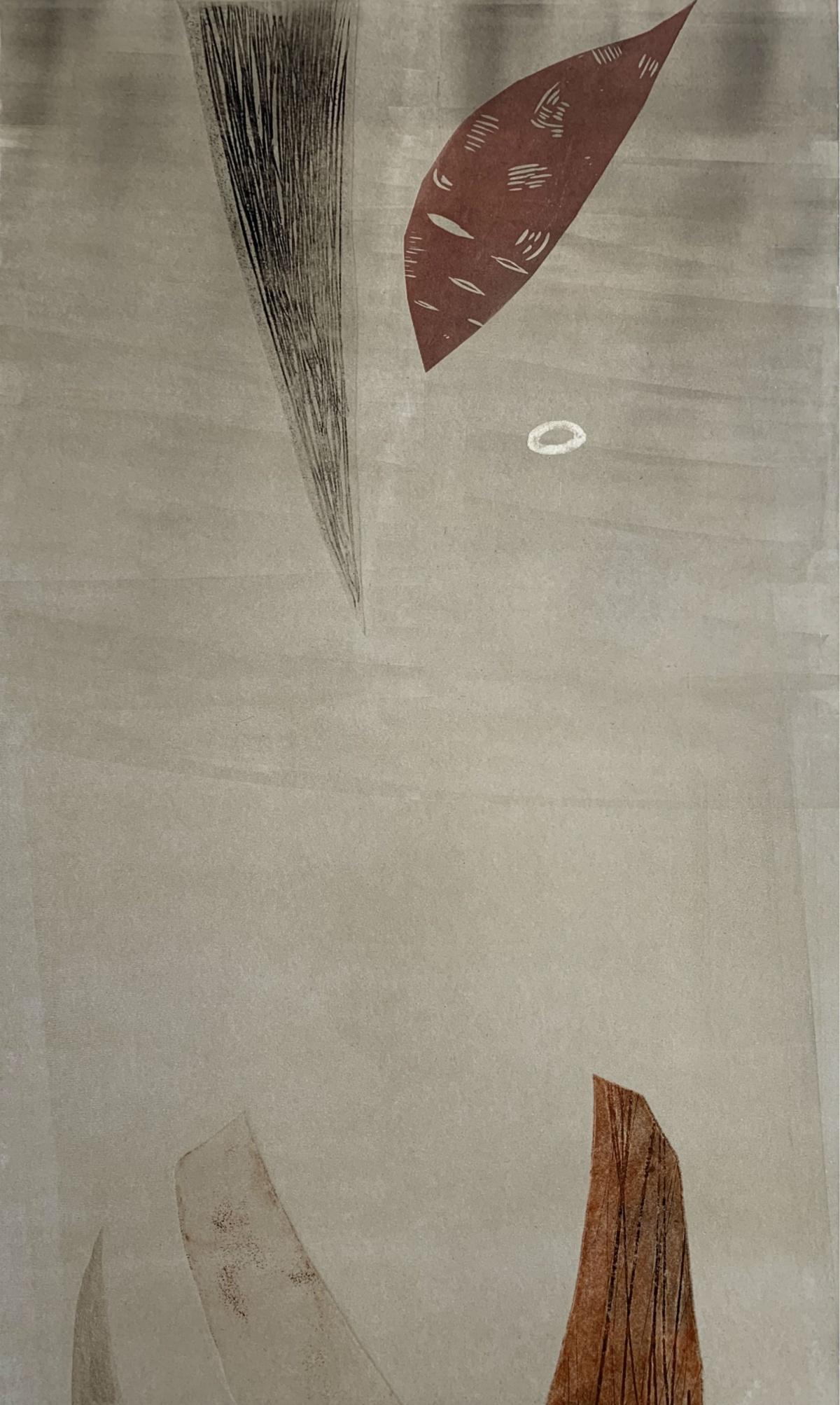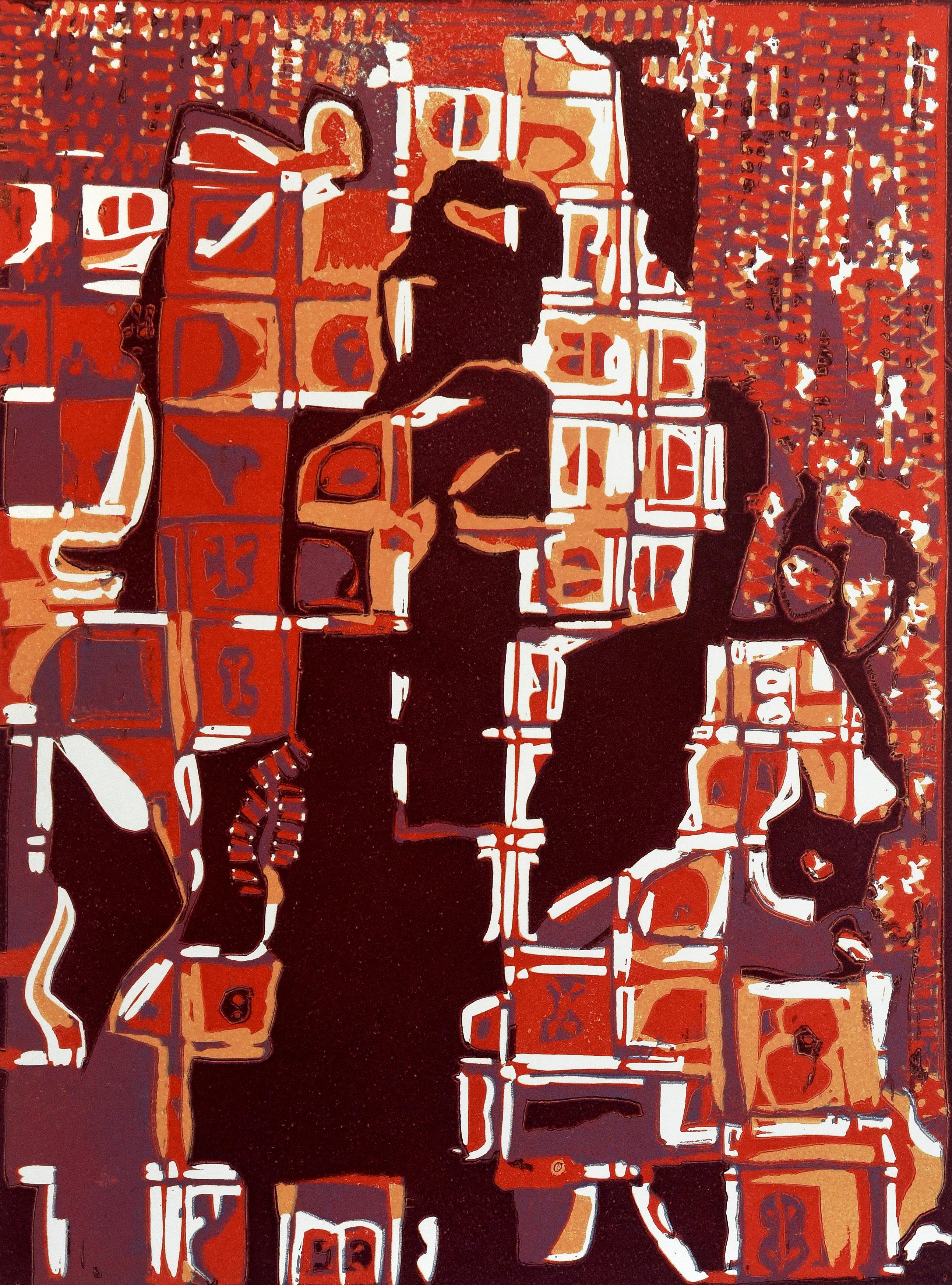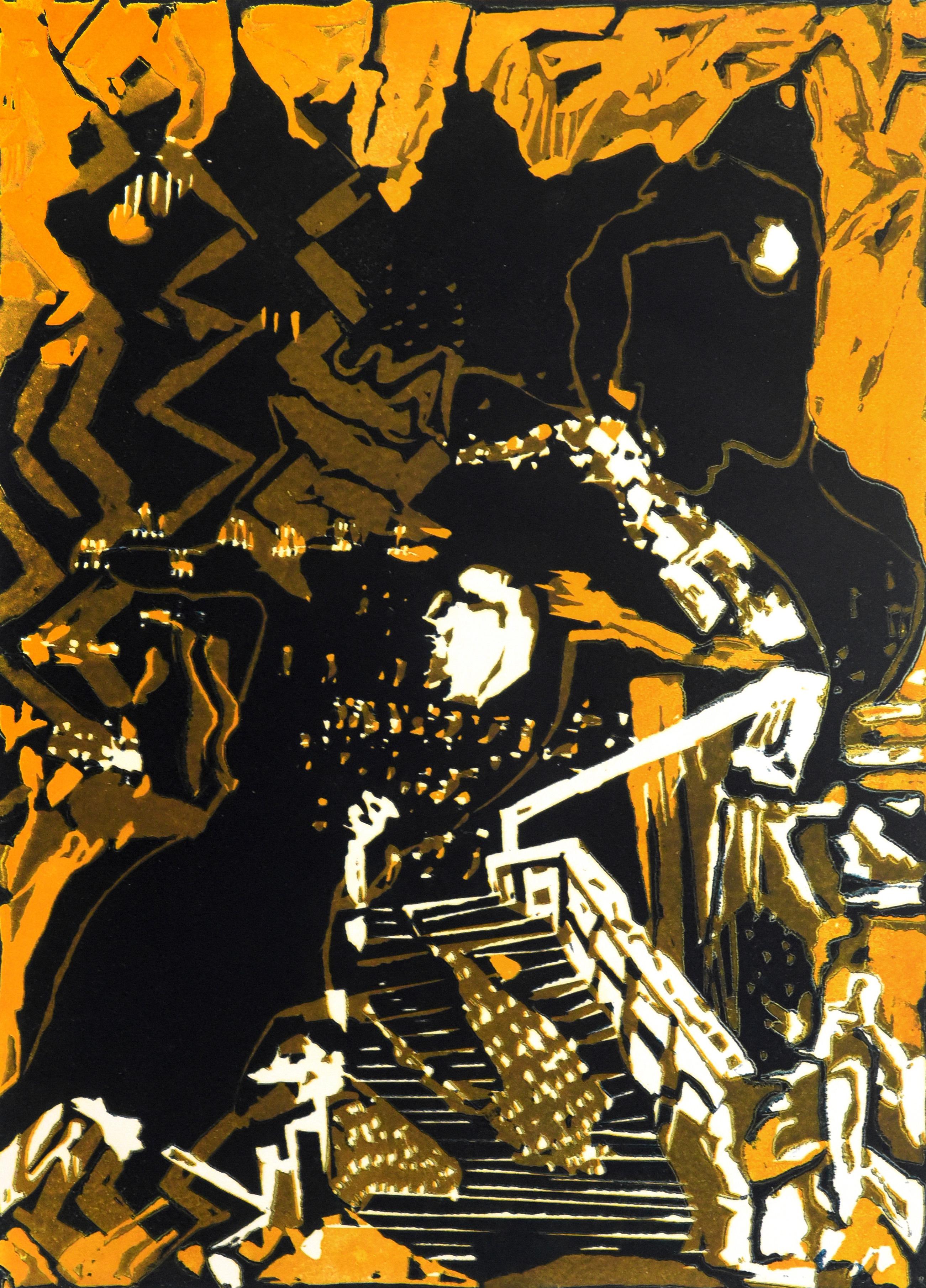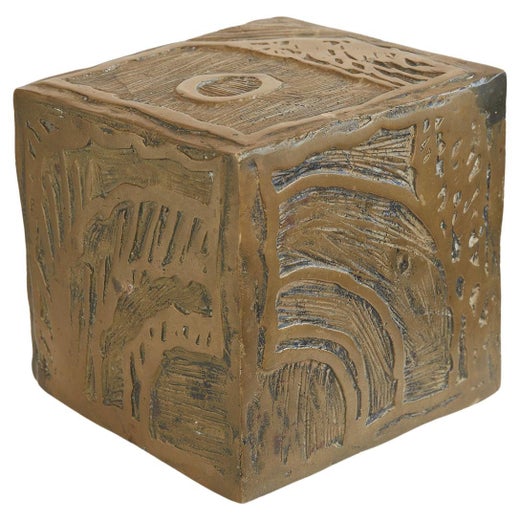Items Similar to Lino Litho BR, Planche IX
Want more images or videos?
Request additional images or videos from the seller
1 of 13
Pierre AlechinskyLino Litho BR, Planche IX1970
1970
About the Item
Lino Litho BR, Planche IX
Linocut and lithograph, 1970
Signed lower right of central image (see photo)
Edition: 99 (56/99) (see photo)
Published by London Arts Group, Detroit
Condition: Excellent
Image size: 15 x 21 1/2 inches
Note: The recipient of the Andrew Mellon Prize in 1977, Alechinsky is represented in the collections of sixty-five of the world's leading
museums
Pierre Alechinsky
B. 1927, BRUSSELS
Born on October 19, 1927, in Brussels, Pierre Alechinsky grew up with varied artistic interests that included graphic techniques, folk art, and medieval book illustrations. From 1944 to 1948 he studied art at the École nationale supérieure d'architecture et des arts décoratifs (La cambre), Brussels. Alechinsky joined the group Jeune Peinture Belge (also known as Jonge Belgische Schilderkunst, young Belgian painters, 1945–48) and had his first solo exhibition in the Galerie Lou Cosyn, Brussels, in 1947. During a stay in Paris in 1948, he was deeply impressed by the work of Jean Dubuffet and Max Ernst, feeling particularly drawn to the former's Art Brut. In March 1949, Alechinsky visited an exhibition featuring artists from the Cobra group (1948–51) at the Séminaire des arts, an experience that would have a lasting effect. Formed by painters from Copenhagen, Brussels, and Amsterdam, the movement distinguished itself through bold, expressive compositions inspired by folk and children's art, as well as by the work of Paul Klee and Joan Miró.
From 1949 to 1951, Alechinsky devoted himself so intensely to Cobra—organizing exhibitions and running the group's eponymous magazine (eight issues, 1949–51)—that he produced little work of his own. His distinctive use of script as a means of pictorial expression came out of his exposure to Cobra artists such as Karel Appel and Asger Jorn, and in 1951 he moved to Paris to study engraving. While there, he discovered an interest in Asian calligraphy. He traveled to Japan in 1955 and the following year made Calligraphie japonaise, a film about Japanese calligraphers. Fascinated by the way they placed paper on the floor and bent over, using their entire bodies to make their works, Alechinsky adopted the method.
Around 1958, his subject matter became more fantastic in nature, and he began using brightly colored acrylics to render comically deformed creatures that often communicate via speech bubbles. The creatures recall Hieronymus Bosch, Pieter Brueghel, and James Ensor—Flemish painters that Alechinsky admires and to whom he sometimes pays homage in his paintings. Since the mid-1960s, Alechinsky has worked primarily on paper. He has returned to his roots as a student in Brussels in his later work that refers to medieval pictorial illustration. From 1983 to 1987 he was a professor of painting at the École nationale supérieure des beaux-arts, Paris. His work has been included in group exhibitions at the Institute of Contemporary Arts, London (1958); Venice Biennale (1960, 1972); Pittsburgh International (now Carnegie International, 1961, 1977); São Paulo Biennial (1963, 1989); and Guggenheim Museum (2009), among other venues. He has received numerous international solo exhibitions at institutions as diverse as the Palais des beaux-arts, Brussels (1955, 1969); Stedelijk Museum, Amsterdam (1963); Museum of Fine Arts, Houston (1967); Musée national d'art moderne Centre Georges Pompidou, Paris (1975, 2004); Guggenheim Museum (1987); Taipei Fine Arts Museum (1992); and Jeu de Paume, Paris (1998, 2003). Museés royaux de beaux-arts de Belgique, Brussels, mounted a major retrospective in 2007. Alechinsky lives and works in Paris.
Courtesy Gugenheim
- Creator:Pierre Alechinsky (1927, Belgian)
- Creation Year:1970
- Dimensions:Height: 15 in (38.1 cm)Width: 21.5 in (54.61 cm)
- Medium:
- Movement & Style:
- Period:
- Condition:
- Gallery Location:Fairlawn, OH
- Reference Number:
Pierre Alechinsky
Pierre Alechinsky is a belgian painter born in 1927 in Brussels. Attracted by painting, Pierre Alechinsky begins aged 17 in the Ecole Nationale Supérieure d'Architecture et des Arts Décoratifs de la Cambre in Brussels. He was involved in the Cobra artistic movement with Karel Appel and Asger Jorn and organised exhibitions. In the early fifties, he learnt the art of engraving with Stanley William Hayter and also Japanese calligraphy. He met Giacometti, Bram Van Velde, and Victor Brauner. In 1955, he signs for his first exhibition at the Palais des Beaux-Arts de Bruxelles, then at the Institute of Contemporary Arts of London. His artworks, prints, lithographies, engravings and books illustrations can also be found in the USA, in France, in the Netherlands, Denmark and Germany. On and after 1965, fascinated by the Oriental calligraphy, he uses acrylic painting, ink, different types of paper as bills, and gets carried away by action painting technique. During the eighties, he became for four years a teacher of plastic arts at the Ecole Nationale Supérieure des Beaux Arts. Also a writer, Pierre Alechinsky published many books including «Titres et pains perdus », « Baluchon et ricochets », and in 2004 «Des deux mains ». He lives and works in France.
About the Seller
5.0
Recognized Seller
These prestigious sellers are industry leaders and represent the highest echelon for item quality and design.
Platinum Seller
These expertly vetted sellers are 1stDibs' most experienced sellers and are rated highest by our customers.
Established in 1978
1stDibs seller since 2013
713 sales on 1stDibs
Typical response time: 1 hour
Associations
International Fine Print Dealers Association
- ShippingRetrieving quote...Ships From: Fairlawn, OH
- Return PolicyA return for this item may be initiated within 10 days of delivery.
More From This SellerView All
- Icare- IcarusBy André VerdetLocated in Fairlawn, OHIcare- Icarus Linocut in colors, 1972 Unsigned Stamped in ink on verso: "Imprimerie Arnéra" Archives/ Non Signé Provenance: Arnéra Archive Frederick Mulder, Lt...Category
1970s Abstract Abstract Prints
MaterialsLinocut
- Untitled (pour XXe Siecle)By Alberto MagnelliLocated in Fairlawn, OHLinocut, printed on yellow wove paper Unsigned as is usual From: XXe Siecle, Volume 13, 1959 Published by G. San Lazzaro for A. Maeght, Paris Printed by...Category
1950s Abstract Geometric Abstract Prints
MaterialsLinocut
- Déesse- GoddessBy André VerdetLocated in Fairlawn, OHDéesse- Goddess Linocut in colors, 1972 Unsigned Stamped in ink on verso: "Imprimerie Arnéra" Archives/ Non Signé Watermark: Arches (see photo) An impression printed in black, purpl...Category
1970s Abstract Abstract Prints
MaterialsLinocut
- Lino Litho BR, Planche VIBy Pierre AlechinskyLocated in Fairlawn, OHLino Litho BR, Planche VI Linocut and lithograph, 1970 Signed lower right in pencil (see photo) Edition: 99 (56/99) (see photo) Published by London Arts Group, Detroit Condition: Exc...Category
1970s Abstract Abstract Prints
MaterialsLinocut
- Festival No. 6By Katsunori HamanishiLocated in Fairlawn, OHFestival No. 6 Color woodblock, 2002 Signed, titled and numbered in pencil (see photos) Edition: 50 (10/50), see photo Provenance: Ninion and Sheldon Landy Collection, Donors to A...Category
Early 2000s Abstract Abstract Prints
MaterialsWoodcut
- Untitled From: Gates to Times Square (20 screenprints, 2 lithographic additions)By Chryssa Vardea-MavromichaliLocated in Fairlawn, OHSigned in pencil Edition 100 Printer: Styria Studio, Inc., NY, with their blindstamp This earlier (1966) sculpture of the same title is the inspiration of the portfolio. The sculpture is in the collection of the Albright Knox Museum. The screenprints follow the neon of the sculpture. Greek-born American sculptor Chryssa—who went by her first name professionally—died on December 23, 2013, reports Margalit Fox of the New York Times. Born in 1933 in Athens, Chryssa Vardea-Mavromichali grew up during the Nazi occupation of Greece. After studying at the Académie de la Grande Chaumière, Paris, and the California School of Fine Arts, San Francisco, she began incorporating neon into her fragmentary, text-based work. Her first solo exhibition in New York was held at the Betty Parsons Gallery in 1961, which was quickly followed by shows at the Guggenheim, New York; Leo Castelli Gallery, New York; and the Walker Art Center, Minneapolis. Her work is part of collections of major museums, including the Museum of Modern Art, New York; the Whitney Museum of American Art, New York; and the Corcoran Gallery of Art, Washington, DC. Note: A set of Gates...Category
1970s Abstract Abstract Prints
MaterialsScreen
You May Also Like
- Untitled - Mixed print technique, Contemporary abstract printBy Berenika Korecka-SowinskaLocated in Warsaw, PLMixed media print on paper by young Polish artist Berenika Korecka-Sowinska who graduated in 2009 from Academy of Fine Arts in WarsawCategory
2010s Abstract Abstract Prints
MaterialsEtching, Paper, Aquatint, Linocut
- Untitled - Mixed print technique, Contemporary abstract printBy Berenika Korecka-SowinskaLocated in Warsaw, PLMixed media print on paper by young Polish artist Berenika Korecka-Sowinska who graduated in 2009 from Academy of Fine Arts in WarsawCategory
2010s Abstract Abstract Prints
MaterialsLinocut, Paper, Etching, Aquatint
- Non-accidental shapes - XX Century, Colorful Woodcut & Linocut, Abstract PrintBy Ryszard GieryszewskiLocated in Warsaw, PLRYSZARD GIERYSZEWSKI (born in 1936) Graduated from the Academy of Fine Arts in Warsaw in 1964. He is a member of International Association XYLON in Switzerland. He participated in mo...Category
Early 2000s Abstract Abstract Prints
MaterialsPaper, Linocut, Woodcut
- Black sunBy Roger BissièreLocated in Paris, FRLinocut, 1960 Handsigned by the artist in pencil Edition : 80 65.00 cm. x 40.00 cm. 25.59 in. x 15.75 in. (paper) 52.50 cm. x 24.00 cm. 20.67 in. x 9.45 in. (image) After Bissière...Category
1960s Abstract Abstract Prints
MaterialsLinocut
- Abstract Landscape India Edition 3/5 Linocut Print Nature Red Orange BlackBy Mukesh SharmaLocated in Norfolk, GBThere is a natural and raw understanding in Mukesh Sharma’s prints that both depict, and are influenced by, the Rajastani communities of his home town in rural India. In these Limited Edition fine-art prints, made over a period of twenty years, we are offered the colours of India’s ancient land, the textures, light and the patterns that are everywhere. In the patterns of the arable fields to the jali's (carved screens) in the architecture. This work is however not romantic nor nostalgic but shows a deeper rooted need to offer a visual heritage of place, of where the artist is from and the journey that he is taking. The results are both compelling and honest. Mukesh Sharma, Celebration “O”, Lino-cut chin-coll’e on German Ivory paper Edition: 3 of 5, 2005 Image size: 50 x 33 cm / Sheet size: 79 x 55 cm Unframed "In this piece I use multiple layering of image, repetition of shape, layered shapes to inform my life celebration and my investigation into Indian culture" Mukesh Sharma's work: It is often in childhood that paths are set for what we will become. Mukesh Sharma hails from a rural, agricultural village in Rajasthan, India. His Father is a craftsman who fixed and mended farm machinery and understood the working parts in the processes. Sharma followed in his Father’s footsteps, as is often the case in Indian families, but his was not the machines of the fields but the presses of the printing studio. Like his Father, Mukesh Sharma is fascinated with understanding how things work and how he can manipulate the metal in his hands. It is not surprising then that his medium of choice is printing. One of the most physically challenging of all the practices, it can often be physically challenging as well as technical and detailed. In his youth, Sharma would draw with stones on walls and floors. He was lucky his family encouraged this and he is grateful for his early art-training at the Jaipur School of Art but it was at the Baroda Art Department that he was introduced to the great printing traditions of Jyoti Bhatt...Category
Early 2000s Abstract Abstract Prints
MaterialsArchival Ink, Archival Paper, Linocut, Archival Pigment
- Abstract Landscape Indian Art Edition 3/5 Linocut Print Nature Orange AustraliaBy Mukesh SharmaLocated in Norfolk, GBThere is a natural and raw understanding in Mukesh Sharma’s prints that both depict, and are influenced by, the Rajastani communities of his home town in rural India. In these Limited Edition fine-art prints, made over a period of twenty years, we are offered the colours of India’s ancient land, the textures, light and the patterns that are everywhere. In the patterns of the arable fields to the jali's (carved screens) in the architecture. This work is however not romantic nor nostalgic but shows a deeper rooted need to offer a visual heritage of place, of where the artist is from and the journey that he is taking. The results are both compelling and honest. Mukesh Sharma, Jetty 1, Lino-cut chin- coll’e on German Ivory paper Edition: 3 of 5, 2005 Image size: 50 x 33 cm / Sheet size: 79 x 55 cm Unframed ''What mesmerised me was the meeting of the sea and the mountain peak. Where the Jetty, a special curved wooden staircase leading to one end and the deep crystal clear sea at a distance. These scenes were amazing to me." Mukesh Sharma's work: It is often in childhood that paths are set for what we will become. Mukesh Sharma hails from a rural, agricultural village in Rajasthan, India. His Father is a craftsman who fixed and mended farm machinery and understood the working parts in the processes. Sharma followed in his Father’s footsteps, as is often the case in Indian families, but his was not the machines of the fields but the presses of the printing studio. Like his Father, Mukesh Sharma is fascinated with understanding how things work and how he can manipulate the metal in his hands. It is not surprising then that his medium of choice is printing. One of the most physically challenging of all the practices, it can often be physically challenging as well as technical and detailed. In his youth, Sharma would draw with stones on walls and floors. He was lucky his family encouraged this and he is grateful for his early art-training at the Jaipur School of Art but it was at the Baroda Art Department that he was introduced to the great printing traditions of Jyoti Bhatt...Category
Early 2000s Abstract Abstract Prints
MaterialsArchival Ink, Archival Paper, Linocut, Archival Pigment






